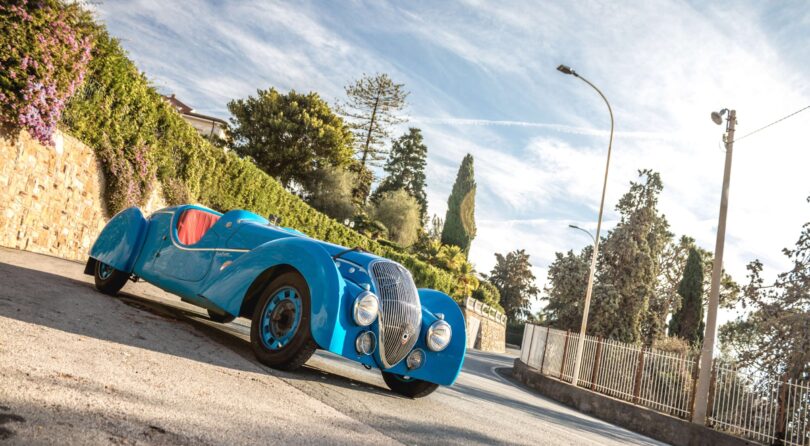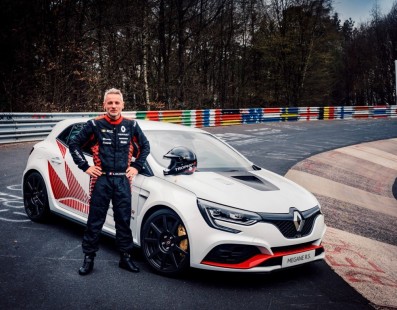GRANDPA’S CAR
Words Remigio Camilla / Photos Alessandro Marrone
I first met this car many years ago at an event for classics built before 1940. I remember being literally fascinated by it: its bodywork was refined, incredibly designed and had one of those so-called flamboyant lines that some famous coachbuilders had created over the ‘30s. It was the first time I saw it, being in admiration for a long time, taking many photographs in order to be able to remember it well in every detail and looking for documentation. Unfortunately, from that moment on I had never had the opportunity to see it again. Until now.

It is a very rare car from the second half of the 1930s, it is French, it is sporty and its aerodynamic and sinuous lines were designed by a dentist with a great passion for cars. It took some time, but thanks to the help of passionate collectors of vintage cars friends, I managed to find it, involving its young driver Ilaria and her mother Rosita, daughter of the previous owner. They provided me with a lot of useful and interesting information and satisfied my interest, thus being able to tell the whole story on these pages.


Mirko was a proper enthusiast and collector of vintage cars, the family home overlooks the important and internationally renowned Ospedaletti Circuit, on which international the Grand Prix for motorcycles and cars has been hosted from 1947 to 1972. Currently, this city circuit welcomes the historical revival every two years. At the beginning of 1990, in the workshop of a mechanic friend from Bordighera, Mirko saw for the first time a Darl’Mat 302 Special Sport, whose owner was the son of a driver who raced with a similar model at the 24 Hours of Le Mans. Mirko is literally struck by this vision and falls in love with it. The decision to find one for himself was lightning fast. The undertaking was difficult, because the model is very rare due to its limited production, but he didn’t mind finding one in good condition, it would have been fine even in bad condition and he would have tackled the restoration with the same passion as always, the important thing was to find it and with the documents relating to the engine and chassis in order. With the help of his mechanic friend, he apparently toured almost all of France in search of the Darl’Mat 302 Special Sport, rummaging through many garages, visiting wreckers, collectors and gathering information and contacts, until one day he finally managed to find one in a garage in Grenoble and thus be able to add it to his collection.



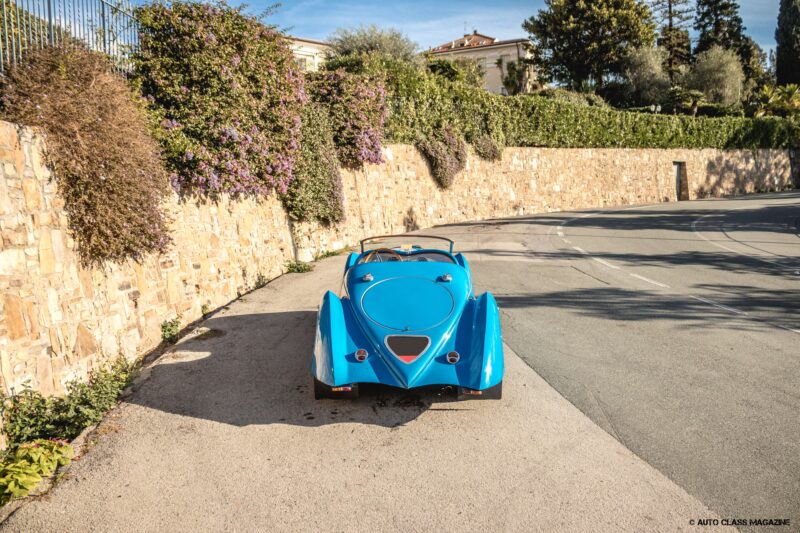
The car was certainly not in mint condition, but with a rather demanding restoration to tackle. The entire chassis, braking system and suspension were complete and recoverable, the same for a large part of the engine block, but the bodywork presented more problems and after a careful examination Mirko found that it was only partially recoverable. He therefore decided to come back to France, in search of everything needed to undertake a correct restoration and complete it in the best possible way, managing to recover the pieces for the reconstruction of the fenders and the wooden supporting structure on which the various shaped sheet metal panels are applied. Having all these important elements available, the restoration of the body could begin and at the same time also think about the mechanics relating to engine and gearbox. Having dismantled the aluminum head, which all Darl’Mats are equipped with – because on the cars from which they derive they are made of cast iron – and after having cleaned it and flattened it, he decided to focus on pistons and valves as well as bushings. As he proceeded with the restoration, however, he found that new parts always had to be replaced, added and found, such as the intake manifold, the double carburetors, another peculiarity of this Darl’Mat tuned engine, compared to the same one equipped as standard with a single carburetor. Another important element to find was the tiny Cotal electromagnetic gear selector, to be positioned on the dashboard behind the steering wheel. It took patient years of research and great passion for the recovery of the existing and the reconstruction of the missing parts, such as the chromed arrow fillet that sinuously runs along the body starting from the grille along the base of the front bonnet and then running along the line of the doors continuing towards the tail.



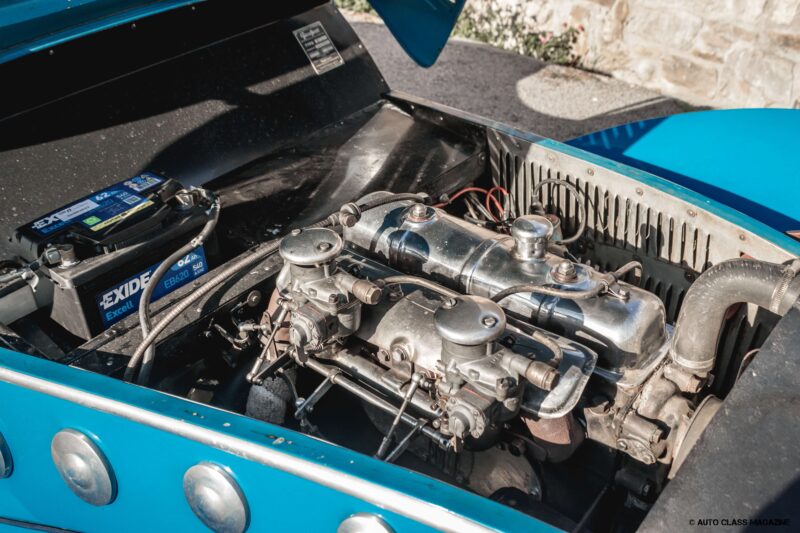



For this creation Mirko looked at Evolani, a historic Turin company specialized in the production of chrome platings, which in turn found valid help for the reconstruction of the shaped and rounded profile at a company that produced women’s handbags with the characteristic to have chrome finishes. Once the work on the bodywork was completed, it was necessary to decide how to treat it chromatically, but in this case it was easy and probably obvious, being a French car model that was used for racing in the 1930s, it could only be the classic and official French Blue. In 1999 and after five years of work, the restoration of the 302 Special Sport was finished and it could finally be registered in Italy. Grandpa Mirko had cultivated and preserved his passion for cars throughout his life, trying over time to leave it as a precious family legacy and today his grandchildren Ilaria and Simone – through the name of “Giovani Centenari” – continue to keep it alive with the help of mother Rosita and father Luigi.
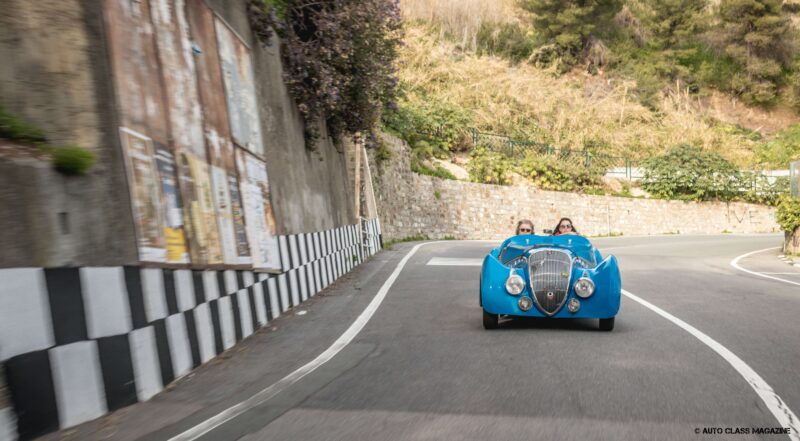
Seeing the Darl’Mat again today along the Ospedaletti Circuit arouses in me the same fascination and attraction of years ago and I pleasantly wonder why. I believe that the most immediate answer lies in its absolute difference compared to the sports cars of the time, as it brings with it the elegance of the aerodynamic design, combined with the characteristics of Art Deco, through the refinement of the used materials. Among the most unusual aspect for a car, the cascade of precious polished aluminum discs with the function of air vents for the engine which run along the profile of the bonnet with increasing diameters, immediately under the arrow-shaped chromed fillet, such as to give it an aspect of modernity, sportiness, speed and dynamism. The lateral indicators are positioned at the base of the windscreen and in circular shape, using a flat ring in polished aluminum that contains a domed crystal, obtained through overlapping concentric, degrading diameters. The position lights are placed on top of the front headlights, also made of polished aluminum, and are treated almost like precious objects, where the small ruby red crystal on the top – to indicate whether they are on or off – and the transparent front crystal are faceted with a jewel cut. Finally, the peculiarity of the imaginative heart-shaped license plate to adapt to the shape of the tail, together with the elements mentioned previously, are just some of the details that give the car that touch of refinement typical of some cars with an aerodynamic design coming out of the 1930s , such as the Figoni et Falaschi, the Bugatti or the creations of Mario Revelli di Beaumont for the various Italian coachbuilders.






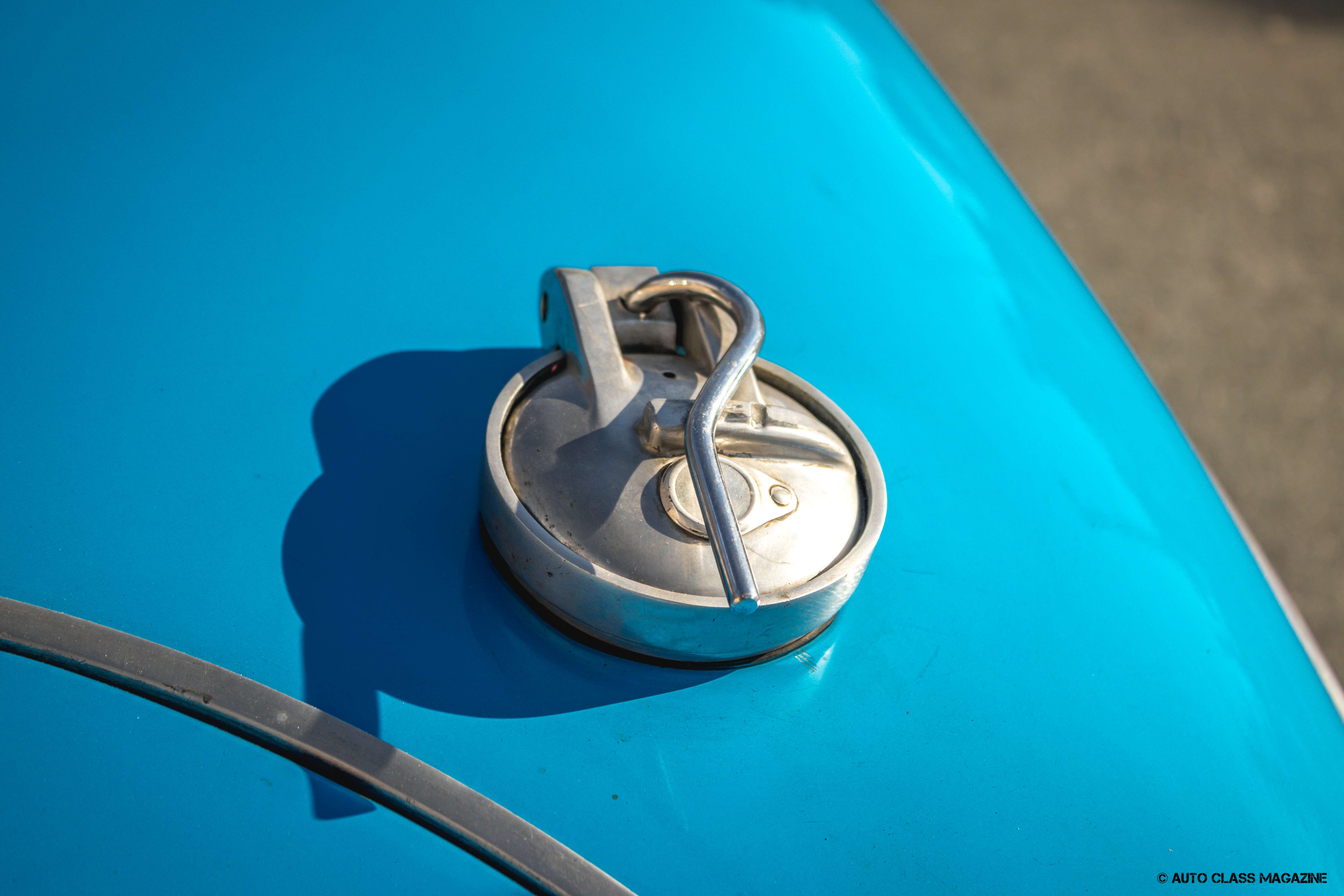


The front glass, with the possibility of being lowered and disappearing inside the bodywork, transforming the car from a spyder into a barchetta, occurs through a mechanism operated by a simple crank placed under the dash and demonstrates the genius of a technical and innovative design of great value, this too is an absolutely unique example in the automotive panorama. The shape of the bodywork seems to have been inspired by the velvety wing of a bat due to the harmonious succession of elliptical and soft lines which contrast with pointed and angular elements such as the mudguards, cusped and sharp, as well as the central part of the rearview mirror which lowers flat forming a point which is connected through two semi-ellipses to the cusp of the rear fenders. In the front view, the shield-shaped chrome grille, strongly rounded and inclined, determines the volume of the central body which dives low compared to the fenders, almost as if they were two wings supporting it. The dashboard is perhaps the most conventional or obvious element on a sports car of that period, using a polished and hammered aluminum plate, the shape of which follows the double hump of the body in correspondence with the front glass.


The instrumentation includes two large circular elements: the rev counter and the odometer with other indicators on a black background. Positioned between these two instruments is the small lever of the electromagnetic gearbox produced by Cotal, one of the mechanical marvels of the era, as well as the ancestor of the automatic gearbox. This is made up of three main elements, the actual gearbox, the lever placed directly on it to select forward gear, parking and reverse and finally the gear selection lever, 4 forward plus reverse ratio. The small gear selector moves through electrical connections inside the gearbox rotating four electromagnets containing the various gear inside, which, depending on the selected ratio, combine to create the various levels of gear reduction. This type of selection works indiscriminately for forward and reverse gear, but above all the use of the clutch is not necessary. It also has the characteristic of being silent and very reliable. The driving position is typical of sports cars of that period, very compact and close to the steering wheel, with enough space in length to allow for straight-legged driving. Behind the passenger compartment and located in the upper part there are two caps relating to the double tank which allow a rapid refueling typical for many racing cars, as well as allowing a perfect weight balance.

The Darl’Mat name of this sports model compared to the standard 302 derives from the surname of the most important Parisian (but not only) Peugeot dealer since 1923, Emile Darl’Mat, who had a mechanic background and was a racing lover as well. As a dealer, to make Peugeot models more performing, he was able to offer customers his own mechanical modifications. At the same time, through his friend Marcel Pourtout, owner of the bodyshop of the same name, he also proposed aesthetic modifications to series models, who made use of the genius of a very unusual designer, a dentist named Georges Paulin, with a great interest in drawing and aerodynamics. In 1934 Paulin and Pourtout had thus designed and built the first convertible coupe on a Panhard and subsequently on a Peugeot 401, on which they mounted a mechanism that acted on a series of levers, with the function of making the solid roof disappear in the trunk. They had named this system Eclipse, because like a real eclipse it allowed the passage from the closed passenger compartment of the car to the vision of the sky and sun. This system had been used on different types of cars, not only Peugeot but also Hotchkiss, Panhard and Lancia Augusta Belna, up to the present day, adopted by various brands for their prestigious models. The Eclipse project was fundamental and with its elegance and genius it constitutes a splendid example of Art Deco applied to the automobile.



Emile Darl’Mat, Marcel Pourtout and Gorges Paulin, at this point, constituted a perfect trio of friends to create the 302 Special Sport. I cannot say whether the idea came from Darl’Mat returning from Le Mans or from the official Peugeot driver Charles de Cortanze who asked Darl’Mat to create a car to race in the 24 hours of Le Mans, as on this argument two versions still exist. The fact is that the idea was good and the three friends began designing the Super Sport. A short and light chassis was needed and the choice fell on that of the new Peugeot 302 put on the market in 1936, the younger sister of the 402, both designed with aerodynamic research by Georges Paulin. For the engine they opted for that of the 402: a 1,991 cc in-line 4 cylinders capable of 50 hp. The Darl’Mat tuning will bring it up to 70 hp through a different aluminum head, the adoption of two carburetors and a different intake manifold. Even the brakes were not derived from the two sedans, but were of larger diameter. Georges Paulin will create the design of the bodywork, with attention to very advanced aerodynamics that was not only intuitive as many others were doing in those years, but verifying it in the wind tunnel according to the concepts of aerodynamic movement. It seems that the source of inspiration was the BMW 328 roadster. The prototype was tested on the Montlhéry circuit to verify its potential in view of Le Mans and Charles de Cortanze – after 24 hours – managed to establish an average speed of almost 145 kph with the prototype and the fastest lap at over 147 kph . The result obtained was exciting, enough to obtain Peugeot’s approval to continue with the project, directly supplying the 308 chassis and 408 engines, but also to link the Darl’Mat name to this car. The three cars built for the 1937 Le Mans 24 Hours had been further improved in performance, so much so that they finished seventh, eighth and tenth overall. The following year, in 1938, was a great success, Charles De Cortanze managed to impose himself in the 2-liter category and place fifth overall.

These excellent placings made the 302 Special Sport very attractive to private drivers, notable among these being Baroness Dorothy Patten who raced on circuits in France and England with her Darl’Mat 308 roadster. To this decidedly sporty model, the Pourtout bodywork, also designed by Georges Paulin, had added some examples on the longer chassis of the 402 to improve its habitability: the cabriolet with fixed and split front glass with non-descending pillar in the centre, as well as some very elegant Coupe. It should be noted that the 302 Special Sport model would evolve in 1938 into the 402 with a shortened chassis, becoming the 302 légère, but this is only an understatement as it is nothing more than a 302 with a new name. Since the 302 Special Sport is handcrafted as Roadster, Cabriolet and Coupe versions, they may differ from each other in some details of the bodywork or dashboard, making them unique models. It is interesting to observe how at the base of the chromed grille the vertical code 302 has the hole for the emergency start crank in the center of the 0. On the top, still in the center of the grille, the brand created by Darl’Mat is composed of the Paris coat of arms enclosed between the claws of the paw of the Lion, Peugeot’s symbol.




Overall, the production numbers are rather limited: apparently 53 road-going Roadsters, 32 Cabriolets and around twenty Coupes, also due to a short production period, from 1937 to 1939. Unfortunately, the dramatic events that emerged with the outbreak of the Second World War put an end to this prestigious project. Georges Paulin unfortunately got the worst of it and died as a hero in 1942, sentenced to death by a German military tribunal and was awarded with the Croix de Guerre as a hero of the French Resistance. Darl’Mat continued his work as a dealer until his natural death in 1970. Marcel Pourtout was active in creating special bodyworks until the mid-1950s, but as the precious collaboration with Georges Paulin ceased, he diversified the activity creating advertising and industrial vehicles with the help of his son.


